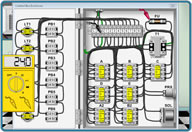Megohm meter/megger selection, uses and buying considerations
|
Megohm meters or sometimes known as meggers are generally used for checking resistant ranges of 20 megohms and above. Most regular ohm meters will max out between 10- 100 megohms. Megohm meters will read anywhere above and beyond 1000 megohms. Megohm meters are commonly used for checking insulation resistance of motors and cables to ground |
|
|
When selecting a megohm meter there are a couple types the first which is what I prefer just because its simple and convenient and easiest to read. ( See image to right). With this megohm meter all you need to do is connect both leads to your motor or device and press and hold the button and view the graph. Where the lights light up will tell you if the motor or cable is good bad or within a range to take a closer look into. Keep in mind servo motors usually have less tolerance for shorting to ground as compared to standard motors. Also resistance can sometimes be read through the insulation on the leads so do not hold them while doing the test. Also make sure you disconnect any leads from drives or boards before testing. The megger puts out a high voltage and could damage your components. The other type is just a standard digital readout like a normal digital multimeter. These are most common. Either one will do but having the ranges and acceptable levels on the meter graph is nice. You generally do not need any fancy graphing or other types of meters for general machine tool repairs. A range of 20-1000megohms is sufficient. Typical servo motors will go well above 1000meg ohms when they are new. Buy this Megohm meter in the cnc store!! |
 |
|






